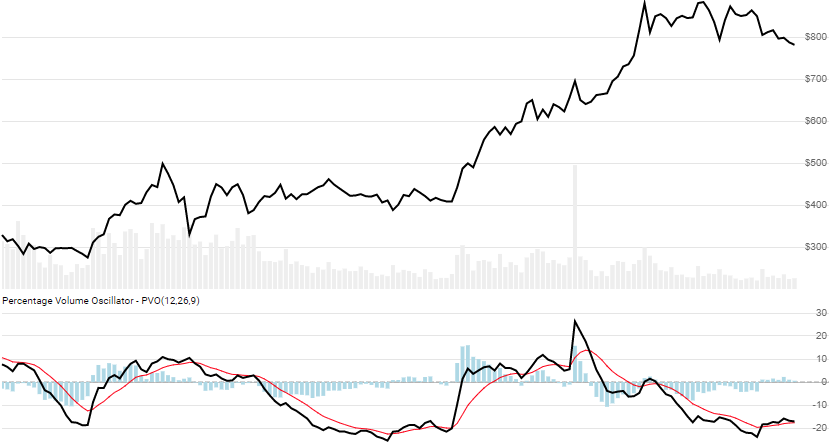Percentage Volume Oscillator (PVO)
The Percentage Volume Oscillator is a simple oscillator view of the rate of change between two converging / diverging exponential moving averages of Volume. [Discuss] 💬

// C# usage syntax
IEnumerable<PvoResult> results =
quotes.GetPvo(fastPeriods, slowPeriods, signalPeriods);
Parameters
fastPeriods int - Number of periods (F) for the faster moving average. Must be greater than 0. Default is 12.
slowPeriods int - Number of periods (S) for the slower moving average. Must be greater than fastPeriods. Default is 26.
signalPeriods int - Number of periods (P) for the moving average of PVO. Must be greater than or equal to 0. Default is 9.
Historical quotes requirements
You must have at least 2×(S+P) or S+P+100 worth of quotes, whichever is more, to cover the warmup and convergence periods. Since this uses a smoothing technique, we recommend you use at least S+P+250 data points prior to the intended usage date for better precision.
quotes is a collection of generic TQuote historical price quotes. It should have a consistent frequency (day, hour, minute, etc). See the Guide for more information.
Response
IEnumerable<PvoResult>
- This method returns a time series of all available indicator values for the
quotesprovided. - It always returns the same number of elements as there are in the historical quotes.
- It does not return a single incremental indicator value.
- The first
S-1slow periods will havenullvalues since there’s not enough data to calculate.
⚞ Convergence warning: The first
S+P+250periods will have decreasing magnitude, convergence-related precision errors that can be as high as ~5% deviation in indicator values for earlier periods.
PvoResult
Date DateTime - Date from evaluated TQuote
Pvo double - Normalized difference between two Volume moving averages
Signal double - Moving average of the Pvo line
Histogram double - Gap between of the Pvo and Signal line
Utilities
See Utilities and helpers for more information.
Chaining
Results can be further processed on Pvo with additional chain-enabled indicators.
// example
var results = quotes
.GetPvo(..)
.GetSlope(..);
This indicator must be generated from quotes and cannot be generated from results of another chain-enabled indicator or method.